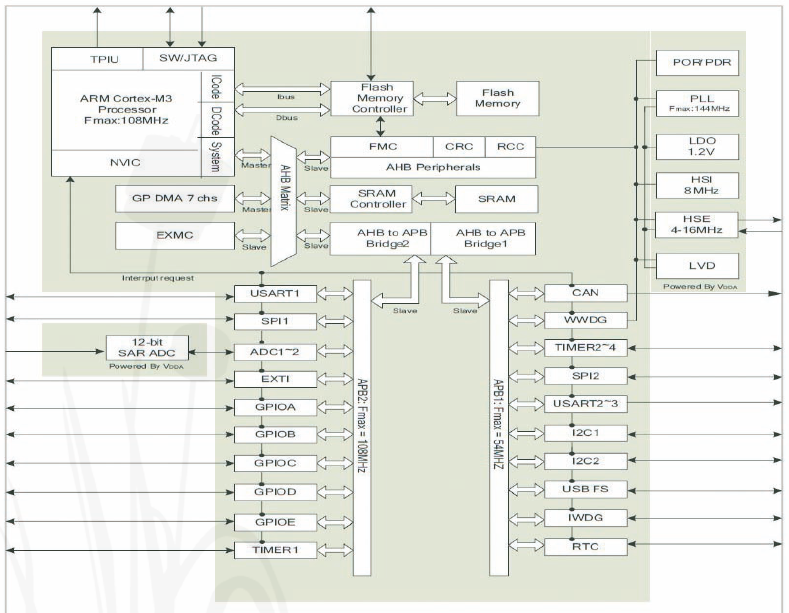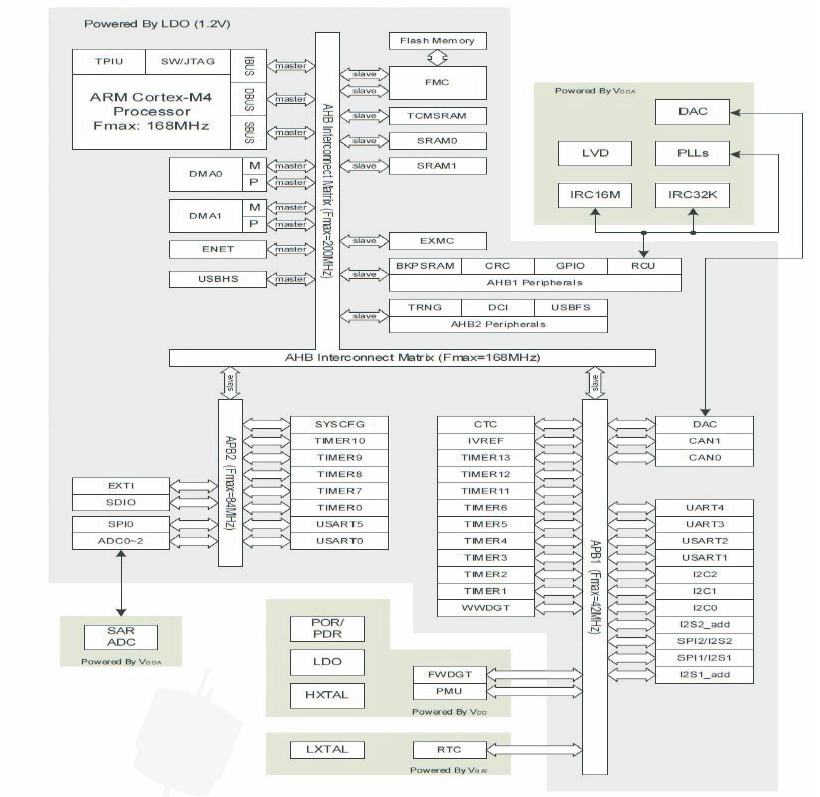Zoltán Kiss- Area Sales Manager - East Europe - Endrich GmbH.
GigaDevice 32 bit ARMCortex microcontrollers (1.)
9 April 2018
![]()
Summary :
ARM (Advanced Reduced Instruction Set Machine) is the industry's leading microprocessor technology, offering the widest range of microprocessor cores to address the performance, power and cost requirements for almost all application markets. With more than 90 billion processors manufactured, the ARM technology is motor of the embedded computers’ World helping solutions to be born and businesses to operate. There are many licensed silicon vendors, software solution providers on this market, but a cost effective fareastern licensed player with its own cost optimized solution helps to keep Worldwide prices on a reasonable lower level. GigaDevice, the well know manufacturer of Flash memories also takes a piece of the cake of ARM® Cortex®M3 technology. Their GD32® family integrates features to simplify system design and provide customers with wide range of comprehensive and superior cost effective MCU portfolios with proven technology and great innovation. In the first part of the series of articles we review the microcontroller architecture, later we show some examples based on evaluation board available for the device.
GD32® is a new 32-bit high performance, low power consumption universal microcontroller family powered by the ARM® Cortex®-M3 or Cortex-M4 RISC cores, which targeted at various MCU application areas. GD32® family integrates features to simplify system design and provide customers wide range of comprehensive and superior cost effective MCU portfolios with proven technology and great innovation. Building on GigaDevice advanced patented “gFlash” memory technology and mass production experiences, it provides new form of MCUs which offers customer high functionality and quality. GD32® family includes entry line, performance line and connectivity line currently. The GigaDevice GD32™ family is wellsuited for a wide range of applications, including industrial control, user interfaces, motor drives, power monitors and alarm systems, consumer and handheld equipment, solar photovoltaic controls, touch panels, PC peripherals and more.

GD32® ARMCortex-M3 Microcontrollers
These microcontrollers are powered by the ARM® Cortex®-M3 RISC core, incorporating the 32-bit ARM® Cortex®- M3 processor core operating at 108 MHz max frequency with Flash accesses zero wait state to obtain maximum efficiency. The GD32F10x series of devices provide up to 3072 KB of on-chip flash memory. From the flash memory the read accesses can be performed 32 bits per cycle without any wait state. Thanks to the long experience of making flash chips, Gigadevice can benefit from this on its ARM microcontroller technology as well. Besides above mentioned features of flash handling, all of byte, half-word (16 bits) and word (32 bits) read accesses are supported. The flash memory can be programmed half-word (16 bits) or word (32 bits) at a time. Each page of the flash memory can be erased individually. The whole flash memory space - except information blocks - can be erased at a time as well. The GD32F1 0x series of devices contain up to 96 KB of on-chip SRAM which starts at the address 0x2000 0000. It supports byte, half-word (16 bits), and word (32 bits) accesses. An extensive range of enhanced I/Os and peripherals connected to two APB buses. The device offers up to three 12-bit 1MSPS (1M samples per second) analog/digital converters, up to ten general-purpose 16- bit timers plus one PWM advanced timer, as well as standard and advanced communication interfaces: up to three SPIs, two I2Cs, five USARTs, an USB 2.0 OTG FS and two CANs.

The device operates from a 2.6 to 3.6 V power supply and available in –40 °C to +85 °C temperature range. Three power saving modes provide the flexibility for maximum optimization between wakeup latency and power consumption, an especially important consideration in low power applications. In order to reduce the power consumption and allow the application to achieve the best tradeoff between the conflicting demands of CPU operating time, speed and power consumption, The PWR provide three types of power saving modes, including Sleep, Deep-sleep and Standby mode. In Sleep mode, only clock of Cortex®-M3 is off. In Deep-sleep mode, all clocks in the 1.2V domain are off, and all ofHSI, HSE and PLL are disabled. The contents of SRAM and registers are preserved. Any interrupt or wakeup event from EXTI lines can wake up the system from the Deep-sleep mode. When exiting this mode, the HSI is selected as the system clock. We should mention that an additional wakeup delay will be incurred if the LDO operates in low power mode. In Standby mode, the whole 1.2V domain is power off, the LDO is shut down, and all of HSI, HSE and PLL are disabled. There are four wakeup sources for the Standby mode, including the external reset from NRST pin, the RTC alarm, the IWDG reset, and the rising edge on WKUP pin. The Standby mode achieves the lowest power consumption, but spends longest time to wake up. Besides, the contents of SRAM and registers (except Backup Registers) are lost. When exiting from the Standby mode, a power-on reset occurs. There are three power domains, including VDD/VDDA domain, 1.2V domain, and Backup domain, as is shown in the following figure 3. The power of the VDD/VDDA domain is supplied by power source, but VDDA and VSSA must be connected to VDD and VSS respectively. Generally, digital circuits are powered by VDD, while most of analog circuits are powered by VDDA. To improve the ADC and DAC conversion accuracy, the independent power supply VDDA is implemented to achieve better performance of analog circuits. An embedded LDO in the VDD/VDDA domain is used to supply the 1 .2V domain power. A power switch is implemented for the Backup domain, it can be powered from the VBAT voltage when the main VDD supply is shut down.

GD32® series of MCUs also bring much advantage to the end-user. The max speed of GD32® MCU has increased 50% than the market competing products. Code execution efficiency of the same frequency has enhanced 30%- 40%. Current consumption of the same frequency has reduced 20%-30%. These performances provide maximum capability and bandwidth options for various market requirements. The above features make the GD32® MCUs suitable for a wide range of applications. It is ideal for use in industrial control, user interface, motor drives, power monitor and alarm systems, consumer and handheld equipment, solar photovoltaic control, touch panel, PC peripherals and so on.

Features
- Flexible memory configurations, with up to 3024 KB on-chip Flash memory and up to 96 KB SRAM memory
- Extensive range of enhanced I/Os and peripherals connected to two APB buses
- Wide range of standard and advanced communication interfaces, including SPI, I2C, USART, USB 2.0 OTG FS and CAN
- Up to three 1 2-bit 1Msps ADCs, up to ten general-purpose 1 6-bit timers, and one PWM advanced timer
- Three power saving modes for maximum optimization between wakeup latency and energy consumption for lowpower applications
GD32® ARMCortexM4 Microcontrollers
The GD32F4 device belongs to the performance line of GD32 MCU Family. It is a new 32-bit general-purpose microcontroller based on the ARM® Cortex®-M4 RISC core with best costperformance ratio in terms of enhanced processing capacity, reduced power consumption and peripheral set. The Cortex®-M4 core features a Floating Point Unit (FPU) that accelerates single precision floating point math operations and supports all ARM® single precision instructions and data types. It implements a full set of DSP instructions to address digital signal control markets that demand an efficient, easy-to-use blend of control and signal processing capabilities. It also provides a Memory Protection Unit (MPU) and powerful trace technology for enhanced application security and advanced debug support. GD32F4 devices suitable for a wide range of interconnection and advanced applications, especially in areas such as industrial control, consumer and handheld equipment, embedded modules, human machine interface, security and alarm systems, graphic display, automotive navigation, drone, IoT and so on.
Features
- Flexible memory configurations, with up to 3024 KB on-chip Flash memory and up to 96 KB SRAM memory
- Extensive range of enhanced I/Os and peripherals connected to two APB buses
- Wide range of standard and advanced communication interfaces, including SPI, I2C, USART, USB 2.0 OTG FS and CAN
- Up to three 1 2-bit 1Msps ADCs, up to ten general-purpose 1 6-bit timers, and one PWM advanced timer
- Three power saving modes for maximum optimization between wakeup latency and energy consumption for lowpower applications
Development tools
GD32® family integrates features to simplify system design and provide customers wide range of superior cost effective MCU portfolios with proven technology and great innovation. Keil development tools - available at http: //www2.keil.com/gigadevice - provide comprehensive support for GigaDevice microcontroller devices in a complete development environment for creating, debugging and verifying embedded applications.

| Share on Facebook | Share on LinkedIn |
References
This article has been published on the following locations:
| # | Media | Link |
|---|---|---|
| 1 | Elektronet 2018/3 | Elektronet : elektronikai informatikai szakfolyóirat, 2018. (27. évf) 3. sz. 27-30. old. |
| 2 | Elektronet online | GigaDevice 32 bites ARM Cortex mikrokontrollerek az Endrich kínálatában |
| 3 | Hungarian version | GigaDevice 32 bites ARM® Cortex® mikrokontrollerek - 1 |
| 4 | Jövő Gyára online | Mikrokontrollerek sokoldalú alkalmazása |
| 5 | New Technology online | GigaDevice 32 bites ARM® Cortex® mikrokontrollerek |
| 6 | New Technology 2018/3 | 2018. 3. sz. 23-25.o. |
| 7 | South-East European Industrial Market 2018/2 | GigaDevice 32 bit ARM® Cortex® - microcontrollers |


